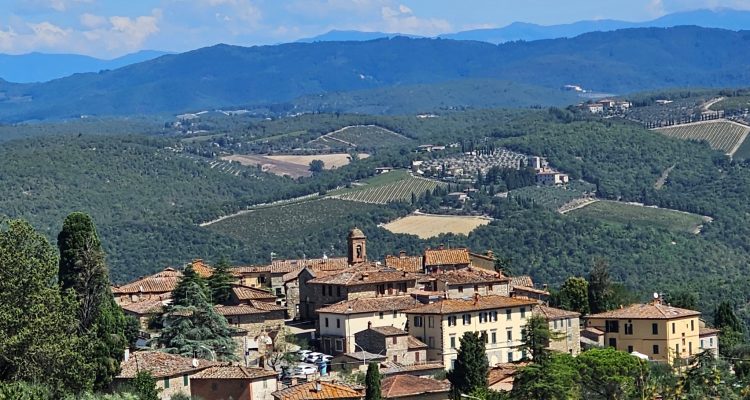The hilly Chianti Classico region in the heart of Tuscany reminds me of Piedmont where wineries huddle around the hill villages of the 11 Barolo communes.
In Chianti Classico, the number 11 now has a special meaning. In July 2021, the Consorzio Vino Chianti Classico approved the use of a territorial label—UGA or additional geographic units (unità geografiche aggiuntive)—established by the EU wine laws of 2013. Chianti Classico DOCG Gran Selezione wines from the 11 UGAs can now label their wines UGA to designate the geographic and cultural characteristics of the wine.
Giovanni Manetti, owner of Fontodi winery and president of the Consorzio Vino Chianti Classico views the UGA project as the new beginning of the Chianti Classico DOCG appellation.
“I represent the generation who wanted to sub-define Chianti Classico,” said Manetti. “In the 1980s, vintners thought Chianti Classico should taste the same north to south. That thinking has changed. Our region is complicated with hundreds of factors influencing the wine. We welcome the launch of UGAs to differentiate our winemaking areas.”
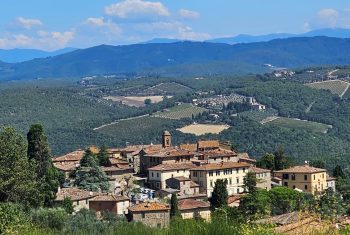
With the opportunity to experience the excitement around the UGA project, I visited several wineries in the Chianti Classico region. The backstory of the wineries and their owners portrays their passion for quality wine and land stewardship.
Before we explore the wineries, let’s dig into Chianti history. In 1716 Cosimo III, the Grand Duke of Tuscany, delimited the Chianti production zone between Florence and Sienna. The Consorzio Vino Chianti Classico, the first consorzio (association) of any Italian wine or food group, formed in 1924 with 33 Chianti producers.
By 1932 so many vintners made lesser quality Chianti outside the Chianti region that producers defined and named the Chianti Classico region with rules on the minimum amount of Sangiovese in blends. The region received DOCG status with specific geographic boundaries in 1984.
A new category for DOCG wines with tightened quality standards, launched in 2014 and now accounts for about six percent of Chianti Classico production. Gran Selezione wines require a minimum of 90 percent Sangiovese with other red indigenous grapes. The less stringent designations, Chianti Classico Annata and Riserva, require only 80 percent Sangiovese and allowed international varietals.
Unlike the MGA classifications of Barolo, or the cru and climat categories in Burgundy, which often represent specific, small vineyards or quality groupings, the UGAs cover larger areas. The Chianti Classico region is nearly 10 times larger than Barolo with over two-thirds covered in forest.
The hilly geography of Chianti Classico variations in soil from calcareous limestone rocks called pietraforte to clay. Manetti calls Dr. Alessandro Masnaghetti “The Map Man” because he defined the UGA borders based not on common terroir, but on a combination of geography and historic viticultural traditions.
Descriptions of the wine styles from each UGA is best covered in Masnaghetti’s compendium, “Chianti Classico: The Atlas and Vineyards of the UGAs” published by Enogea.
Fontodi in Panzano UGA
With roots in Chianti since the 1600’s, Manetti’s family manufactured terracotta used in pottery, olive oil jars and amphoras for wine fermentation and aging in Il Ferrone south of Florence. After the terracotta business slowed, Manetti’s father purchased 12 hectares of vineyards in 1968. The winery now owns 110 hectares and continues to use amphoras
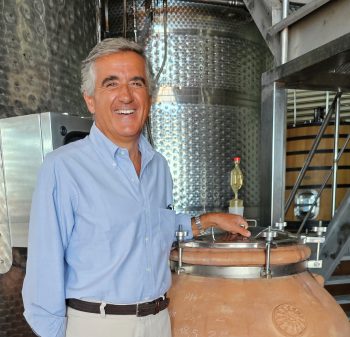
Manetti noted that for vineyard health, the winery is adding biodynamic practices. Grapes are handpicked, manually sorted, pressed, and sent to the cellar via gravity flow where natural yeast launches fermentation.
With 20 percent of the vineyard in old vines, Manetti is especially pleased with the 2019 Fontodi Vigna del Sorbo Gran Selezione. As I enjoyed the wine’s richness balanced with a healthy amount of acidity, I surmised it would age well. Manetti then surprised us with a 1993 Vigna del Sorbo, still fresh with citrus notes.
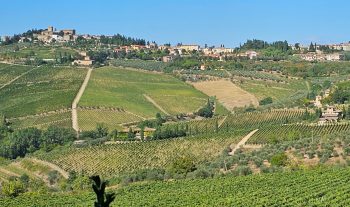
Rocca delle Macie in Castellina UGA
Sergio Zingarelli’s father Italo was founder of Rocca delle Macie and the famous producer of “spaghetti westerns,” such as “My Name is Still Trinity” which featured cowboy action mixed with humor. A gastronome who dreamed of owning a winery, Italo bought the dilapidated Le Macie farm in 1973. Starting with 10 hectares, the family now farms 200 hectares. As a greeting to visitors, the family installed a stage-set sized black rooster, the Chianti Classico logo which harks back to the ancient rivalry between Florence and Siena.
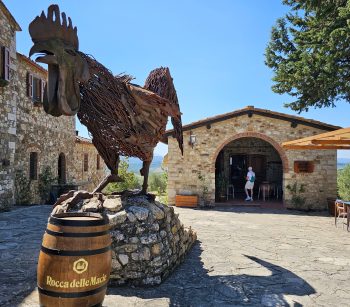
As president of the Consorzio from 2012 to 2018, Sergio Zingarelli oversaw the implementation of the Gran Selezione category of Chianti Classico. I attended a memorable vertical tasting of Sergio Zingarelli Chianti Classico Gran Selezione in San Francisco in 2022.
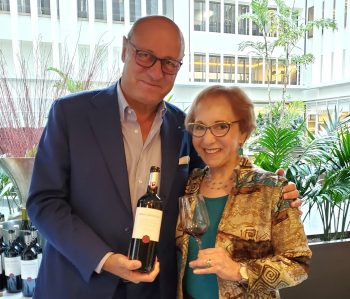
Following more study of their vineyards, Zingarelli hired a new enologist in 2010 who focused on single vineyard wines. He supports the new UGA typology and the advantages of terroir-driven winemaking. Arriving at Rocca delle Macie during harvest season, we first tasted freshly-picked grapes from three single vineyards before tasting the wine.
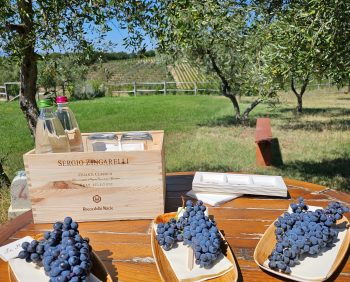
Our lunch at the winery started with a pairing of 2015 Rocca delle Macie Chianti Classico Fizzano Riserva Gran Selezione pairing with brushetti. The wine’s long fermentation contributed to its velvety smooth mid-palate and spicy warm finish.
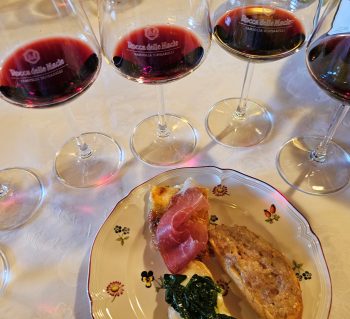
A notable aspect of the hospitality focus of the Zingarelli family is their renovation of the small, medieval hamlet of Fizzano on a hill surrounded by vineyards. The site, known as Relais Riserva di Fizzano, comprises apartments, a gourmet restaurant and shop. “We started this project to give visitors the same emotions we feel every day at Rocca delle Macie,” said Zingarelli.
San Giusto a Rentennano in Gaiole UGA
As we negotiated the gravel driveway to San Giusto a Rentennano, I relished the rustic view of trees and vineyards. Owner Luca Martini di Cigala welcomed our group and led us to several vineyards.
Martini di Cigala dug his hands into the firm limestone soil called alberese and explained that his crew makes two passes at different times during the growing season to clip off immature grapes. He also pointed out his self-designed netting system to reduce sunburn as the influence of global warming has resulted in 100+-degree temperatures. I asked the vintner if he was an engineer and he said, “No, I’m a farmer.”
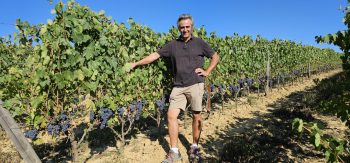
The family surname reflects his dual Italian heritage. While Cigala is a Tuscan name, his grandmother was from the famed Martini family in Piedmont. The winery buildings, once a medieval Cistercian nunnery, were purchased by Martini-Cigala’s grandfather in 1914. Though the family’s wine was lost during World War II and then sold locally, broader distribution began in 1979. Martini di Cigala transitioned to organic farming 20 years ago.
During the tasting in the dining room of the family house, we savored a Tuscan-display of hospitality with local cheeses such as young, primo sale ( first salting) Pecorino and Prosciutto Toscano. We tasted top wines such as San Guisto a Rentannano Chianti Classic Gran Selezione 2016 with wild berry aromas and well-textured Sangiovese. Tastings are free with the opportunity to view many historic documents and objects.
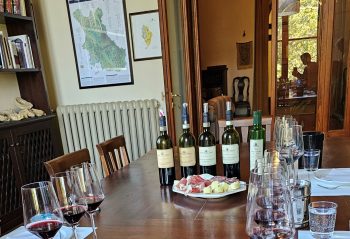
I Fabbri in Lamole UGA
We traveled from Gaiole, one of the largest UGAs with 41 wineries, to Lamole, the smallest with eight wineries. Here we met Susanna Grassi who shared the backstory of I Fabbri. “Though 11 generations of my family have owned this land since 1620, I am the first woman owner due to Italy’s patriarchal inheritance laws. While my engineer father lived abroad, I dreamt of leading the winery. Half of Lamole vineyards were abandoned during the 1950s. In 2000 I promised my father I would reinvigorate our land. After replanting, the fragile situation has transformed into healthy vineyards.”
The former fashion designer drove us up the hill facing her family’s vineyards and castello where tastings are held. She talked about the natural amphitheater where their organic grapes ripen on nine hectares with sunny exposures. The area is on the Italian National Registry of Rural Landscapes.
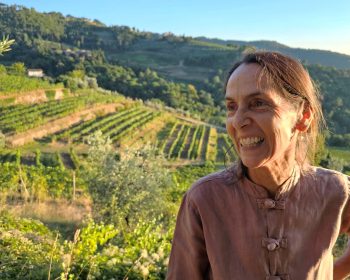
Grassi is a gracious host offering meals with tastings. Our Tuscan dinner started with a traditional tomato soup thickened with stale bread followed by arrosto, roasted pork loin in a mustard sauce. The robust and ageable I Fabbri Riserva Terra di Lamole Gran Selezione paired well with the meat.
For dessert, we enjoyed pasta frolla, a Tuscan specialty of shortcrust pastry filled with custard. I Fabbri Riserva Gran Selezione 2019 old vines was a fine match with the not-too-sweet, creamy dessert.
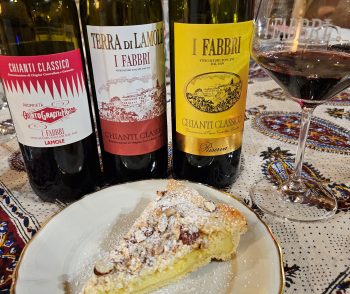
Castello di Albola in Radda UGA
Raddi, at the physical center of Chianti Classico and one of the three villages named in the 1716 Chianti delineation, is home to Castello di Albola. Previously owned by several noble families, the Zonin family of Prosecco fame in the Veneto region purchased the winery in 1979 and now farms 125 vineyard hectares.
Alessandro Gallo, the estate’s director and winemaker, joined the winery in 2004. I met Gallo over a dozen years ago and remembering his well-balanced wines and warm hospitality, I was eager for an update on the winery.
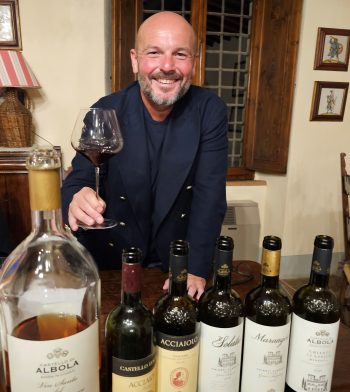
After a long day of travel, I arrived at the winery hungry and welcomed grapes fresh from the vineyard baked into a most delicious Tuscan focaccia called schiachiata con l’uva. When the grapes are ripe, the chef leaves the kitchen and picks them for his cooking.
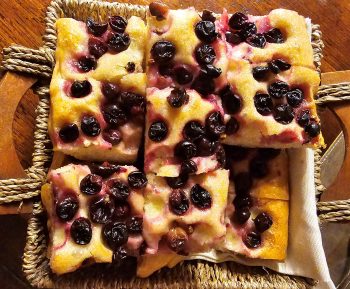
As at our previous meeting, Gallo expressed the same highest regards for careful vineyard management with low yields. He added, “Sustainability for the land and people is a key focus. We seek biodiversity in the vineyard and partner with various organizations on viticulture and agronomic experimentation.”
Gallo mused about the change in perception of Chianti Classico wines which previously emphasized acidity above all. Now, he said, winemakers seek an overall mouthfeel that balances tannin and grape concentration.
Our dinner began with steak tartare from the winery’s own cattle and was paired with full bodied, single vineyard 2015 Marangole Chianti Classico Gran Selezione. We also savored rich, tomato sauced pasta and mille feuille beef with other single vineyard wines.
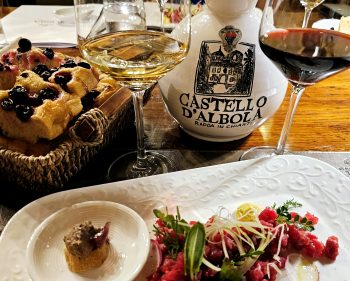
The winery is a popular destination with 33,000 visitors a year. Of special interest are cooking classes and cave tours which include a tasting and meal.
The future
“The UGA program is a passion of mine. Chianti Classico is a big area. We need to preserve and elevate each of the 11 areas,” said Gallo.
Consorzio president Manetti at Fontodi believes Chianti Classico is well-positioned for the impact of climate change. “Water may be an issue if drought occurs or too much rain brings mildew. But 65 percent of land in Chianti Classico is forest which has a tremendous cooling effect. These natural coolants mitigate over ripening which creates high alcohol wines.”
Overall, the vintners look forward to putting UGA on their labels. Although understanding the change will take time, the expectation is that consumers will take note, too.
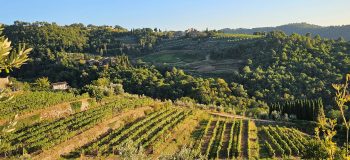
Photos by Deborah Grossman

